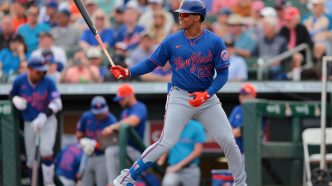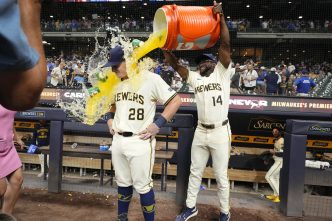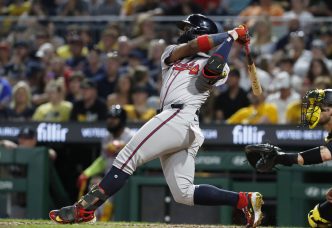The scene is set against the backdrop of a bustling New York evening, the sun casting a golden hue over the city. It’s a fitting stage for Steve Cohen, the billionaire hedge fund mogul and owner of the New York Mets, as he steps into the illustrious Christie’s auction house. Acquiring a Giacometti sculpture is no small feat, especially when you consider that pieces by this Italian artist dominate the realm of high-value art, with four out of the five most expensive sculptures sold at auction averaging a staggering $106.25 million each.
On that night in May of 2015, Cohen was not there to simply browse; he was about to enter a high-stakes bidding war for Giacometti’s “L’homme au doigt,” a masterful piece that encapsulates the essence of modern sculpture. Created in the artist’s signature frenetic style back in 1947, this powerful figure was projected to garner around $130 million. Initially, Cohen had no intention of participating, but a thought flickered into his mind: “You would have the best Giacometti collection in the world.” Just like that, he pivoted.
The bidding escalated swiftly, hitting $126 million, and with a single bang of the gavel, Cohen walked away with what would become the highest auction price ever for a sculpture at $141.3 million, a moment he humorously reflects upon as being swept away in the thrill of the moment.
Fast forward almost a decade, and Cohen finds himself in a similar high-stakes situation, but this time in the realm of baseball—specifically, in the competitive arena of free agency with Juan Soto. At just 26 years old, Soto has solidified his place as one of baseball’s most elite hitters, a fact underscored by his unprecedented record of seven seasons with an adjusted OPS of no worse than 142 through age 25—an indicator of dominance that is rare in the sport. Cohen, looking to capitalize on this rare opportunity, understood the significance of acquiring such talent: “There wasn’t going to be another player like him on the market maybe in the next five, six, seven years.”
The bidding for Soto, however, was far more intense than any art auction, feeling more akin to a heavyweight title fight. Cohen’s gut told him Soto would lean toward the Yankees, but in a stunning twist, Cohen emerged victorious. The details of Soto’s 15-year, $765 million contract, the largest ever guaranteed in sports history, expressed more than just financial might; it signaled a commitment to reshaping the Mets’ longstanding narrative of near-misses and disappointment.
Drawing on his own Mets fandom, Cohen articulated his desire to elevate the team’s image and end the franchise’s notorious stigma—the “Wile E. Coyote” of baseball—where progress is often thwarted by unfortunate mishaps. Soto, now slotted into a lineup with standout talents like Francisco Lindor and Pete Alonso, undeniably adds a new flavor to a team that recently came within striking distance of the World Series.
Cohen’s vision doesn’t just hinge on winning games; it resonates on a civic level. He accentuates the philanthropic element of transforming the team’s standing, not just for himself but for the millions who share a connection to the Mets. “If I could turn this organization around, I could make millions of people happy,” he reflects, hinting at a deeper purpose behind the spending spree.
The negotiations leading up to Soto’s signing unfolded in a captivating narrative filled with intrigue and guesswork that even had the agents scratching their heads about why the young outfielder chose the Mets over other suitors like the Yankees and Red Sox. In retrospect, the allure of the organization’s family-oriented approach and Cohen’s commitment to enhancing players’ experiences, both on and off the field, seemed to play a pivotal role.
One striking anecdote touches on Cohen’s long-standing relationship with his players—how he prioritized creating an environment where athletes can thrive while ensuring their families are cared for. This approach resonated deeply with Soto and his family, who found that the Mets’ emphasis on personal touch stood out in an industry often dictated by cold transactional interactions.
As discussions progressed, Cohen leveraged his connections with current Mets players, tapping into their insights about Soto’s character and how he might fit into the team dynamic. Additionally, Soto’s spectacular performance at Citi Field—the Mets’ home—became a focal point in the negotiations. A stark reminder of how numbers can be more than just statistics; they embody a narrative of potential.
Boras, Soto’s agent, hinted at the weight of emotional connections in these discussions, framing the decision-making process as one that involved family as the “Supreme Court of Soto,” emphasizing that his family played an instrumental role in deciding the best fit for the young star.
The net result? A historical contract that not only underscores the unprecedented investment Cohen is making in his team but also signals a shift in the perception of the Mets. What was once a franchise known for its misfortunes is beginning to shake off those labels, showcasing potential that fans have longed to see fulfilled.
In Cohen’s eyes, the future hangs on the promise of sustainable success: revitalizing a team long associated with mediocrity into something more profound. He envisions lifting that postseason feeling not just for himself but for an entire fanbase that has endured its fair share of ups and downs over the decades.
As the dust settles on a dramatic offseason, fans are left with a sense of hope — hope that this time, the bright lights of New York will illuminate a franchise on the cusp of establishing itself as a perennial contender. The narrative is poised for a thrilling twist, one that fans are eager to witness as Juan Soto steps into the batter’s box, ready to carve a new chapter in Mets history.







